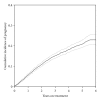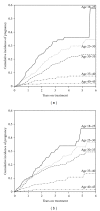Incidence of pregnancy after initiation of antiretroviral therapy in South Africa: a retrospective clinical cohort analysis
- PMID: 22778536
- PMCID: PMC3388336
- DOI: 10.1155/2012/917059
Incidence of pregnancy after initiation of antiretroviral therapy in South Africa: a retrospective clinical cohort analysis
Abstract
Background: Little is known about rates of incident pregnancy among HIV-positive women initiating highly active antiretroviral therapy (HAART).
Methods: We conducted a retrospective clinical cohort study among therapy-naïve women ages 18-45 initiating HAART between 1 April 2004 and 30 September 2009 at an adult HAART clinic in Johannesburg, South Africa. We used Poisson regression to characterize rates and rate ratios of pregnancy.
Results: We evaluated 5,996 women who experienced 727 pregnancies during 14,095 person-years at risk. The overall rate of pregnancy was 5.2 per 100 person-years (95% confidence limits [CL] 4.8, 5.5). By six years, cumulative incidence of first pregnancy was 22.9% (95% CL 20.6%, 25.4%); among women ages 18-25 at HAART initiation, cumulative incidence was 52.2% (95% CL 35.0%, 71.8%). The strongest predictor of incidence of pregnancy was age, with women 18-25 having 13.2 times the rate of pregnancy of women ages 40-45 in adjusted analysis. CD4 counts below 100 and worse adherence to HAART were associated with lower rates of incident pregnancy.
Conclusions: Women experience high rates of incident pregnancy after HAART initiation. Understanding which women are most likely to experience pregnancy will help planning and future efforts to understand the implications of pregnancy for response to HAART.
Figures


Similar articles
-
Effect of pregnancy and the postpartum period on adherence to antiretroviral therapy among HIV-infected women established on treatment.J Acquir Immune Defic Syndr. 2015 Apr 1;68(4):477-80. doi: 10.1097/QAI.0000000000000501. J Acquir Immune Defic Syndr. 2015. PMID: 25559590 Free PMC article.
-
Incident pregnancy and time to death or AIDS among HIV-positive women receiving antiretroviral therapy.PLoS One. 2013;8(3):e58117. doi: 10.1371/journal.pone.0058117. Epub 2013 Mar 8. PLoS One. 2013. PMID: 23520489 Free PMC article. Clinical Trial.
-
Highly active antiretroviral therapy and cervical dysplasia in HIV-positive women in South Africa.J Int AIDS Soc. 2012 Jun 7;15(2):17382. doi: 10.7448/IAS.15.2.17382. J Int AIDS Soc. 2012. PMID: 22713259 Free PMC article.
-
Initiation of highly active antiretroviral therapy among pregnant women in Cape Town, South Africa.Trop Med Int Health. 2010 Jul;15(7):825-32. doi: 10.1111/j.1365-3156.2010.02538.x. Epub 2010 May 18. Trop Med Int Health. 2010. PMID: 20497405
-
Pregnancy and virologic response to antiretroviral therapy in South Africa.PLoS One. 2011;6(8):e22778. doi: 10.1371/journal.pone.0022778. Epub 2011 Aug 2. PLoS One. 2011. PMID: 21829650 Free PMC article.
Cited by
-
Effect of pregnancy and the postpartum period on adherence to antiretroviral therapy among HIV-infected women established on treatment.J Acquir Immune Defic Syndr. 2015 Apr 1;68(4):477-80. doi: 10.1097/QAI.0000000000000501. J Acquir Immune Defic Syndr. 2015. PMID: 25559590 Free PMC article.
-
Exploring the live birth rates of women living with HIV in British Columbia, Canada.PLoS One. 2019 Feb 6;14(2):e0211434. doi: 10.1371/journal.pone.0211434. eCollection 2019. PLoS One. 2019. PMID: 30726263 Free PMC article.
-
Pregnancy incidence and associated factors among HIV-infected female adolescents in HIV care in urban Côte d'Ivoire, 2009-2013.Glob Health Action. 2016 Aug 12;9:31622. doi: 10.3402/gha.v9.31622. eCollection 2016. Glob Health Action. 2016. PMID: 27527503 Free PMC article.
-
Reproductive and maternal healthcare needs of HIV infected women.Curr HIV/AIDS Rep. 2013 Dec;10(4):333-41. doi: 10.1007/s11904-013-0172-x. Curr HIV/AIDS Rep. 2013. PMID: 23918674 Review.
-
Pregnancy incidence and intention after HIV diagnosis among women living with HIV in Canada.PLoS One. 2017 Jul 20;12(7):e0180524. doi: 10.1371/journal.pone.0180524. eCollection 2017. PLoS One. 2017. PMID: 28727731 Free PMC article.
References
-
- UNAIDS. 2009 AIDS epidemic update. http://www.unaids.org/en/dataanalysis/epidemiology/2009aidsepidemicupdate/
-
- Mepham SO, Bland RM, Newell ML. Prevention of mother-to-child transmission of HIV in resource-rich and -poor settings. An International Journal of Obstetrics and Gynaecology. 2011;118(2):202–218. - PubMed
-
- UNAIDS/WHO. Geneva, Switzerland: 2007. AIDS Epidemic Update 2007.
-
- Pettifor AE, Rees HV, Kleinschmidt I, et al. Young people’s sexual health in South Africa: HIV prevalence and sexual behaviors from a nationally representative household survey. AIDS. 2005;19(14):1525–1534. - PubMed
Publication types
MeSH terms
Grants and funding
LinkOut - more resources
Full Text Sources
Medical
Research Materials
Miscellaneous

